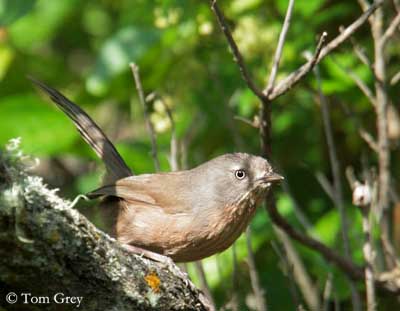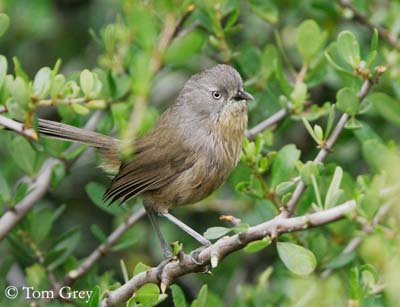
Wrentit
Chamaea fasciata
Passeriformes Order – Sylviidae Family
BIOMETRICS:
Length : 14 à 15 cm
Weight : 13 à 16 g
LONGEVITY : Up to 12 years
DESCRIPTION:
Wrentit colours vary from reddish-brown in northern populations, to greyer in southern birds.
Plumage shows loose texture. It varies from dull olive, olive-brown, dark ruddy-brown to pale brown. Usually, darker upperparts contrast with paler underparts. Throat and breast may be slightly streaked. Wings are short and rounded. Long, rounded tail is very often cocked.
Sides of head and neck are sometimes paler or browner, or both, than rest of upperparts. We can see a faint blackish supercilium contrasting with face and crown. Horn coloured bill is short and slightly curved. Eyes are cream-coloured. Legs and feet are dark grey. Both sexes are similar, and have nearly identical plumage year-round.
DIET:
Wrentit feeds mainly on insects and spiders, but it also eats berries, small fruits and seeds.
PROTECTION / THREATS / STATUS:
Wrentits are preyed upon by jays and snakes for chicks and eggs. Adults also have predators such as feral cats and domestic animals.
Populations are threatened by habitat loss, due to increasing people moving into the chaparral. Wrentit habitat is segmented into isolated areas, by cutting down of underbrush. This species doesn’t fly over open areas, and becomes vulnerable to local extinction.
Fr: Cama brune
All : Chaparraltimalie
Esp : Herrerillo Chochín
Ital : Cincia-scricciolo del Nordamerica
Nd : Winterkoningmees
Russe : Крапивниковая синица
Sd : Messmyg
Photograph by Tom Grey
His website :
Tom Grey's Bird Pictures
Text by Nicole Bouglouan
Sources :
FIELD GUIDE TO THE BIRDS OF NORTH AMERICA by National Geographic Society - National Geographic Society - ISBN: 0792274512
All About Birds (Cornell Lab of Ornithology)
What Bird-The ultimate Bird Guide (Mitchell Waite)
Wikipedia (Wikipedia, The Free Encyclopedia)
BEHAVIOUR:
Wrentit gleans insects, larvae and spiders from bark of trees and twigs, less frequently from green leaves. It also gleans fruit and seeds from tips of twigs. It may hover briefly at flowers, and catch butterflies and moths by fly-catching. It is rarely seen foraging on ground, where it moves by hopping, or walking slowly through shrubs. It performs the “stop – wait – look” method.
Both sexes strongly defend territory. They use vocalizations to announce presence. Head-feathers may be erected, and birds fly towards each other and sing. Tail is very often straight up.



HABITAT:
Wrentit lives in chaparral and brushy areas in forests, and coastal sage scrub, suburban parks and large gardens. It is resident year-round from sea level to 2,300 metres of elevation.
RANGE:
Wrentit is limited to West Coast of North America and mountains, from northern Oregon to Baja California.
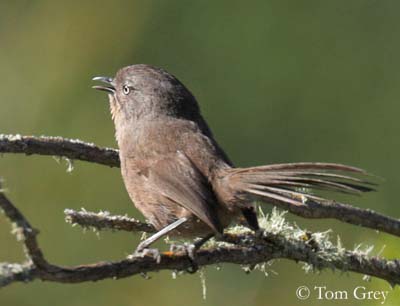
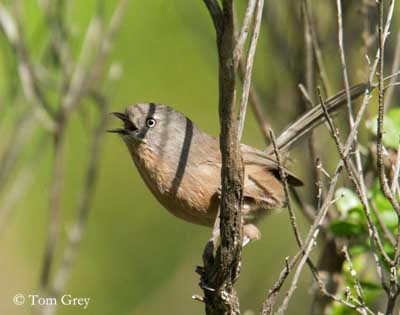
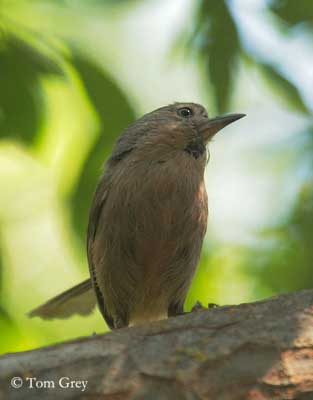
FLIGHT:
Wrentit performs short flights from bush to bush, due to its small wing size. It also hesitates to cross rivers or open spaces more than 10 to 12 metres.
REPRODUCTION:
Wrentit’s nest is situated in dense shrubbery. Nest is cup-shaped, made with grasses and bark strips held together with spider web and silk. Interior is lined with soft plant matter or grass. In order to make the nest well camouflaged, Wrentit often decorates the outside with lichens.
The nest is located in a fork of coastal sage or coyote brush, and birds may reuse old nest materials.
Female lays 3 to 5 whitish blue or green eggs during summer months. Incubation lasts about 15 to 16 days, shared by both parents. Altricial chicks are fed by both adults.
Young fledge about 12 to 22 days after hatching, and parents feed them for one month more, mainly with insects.
Young birds stay within parental territory until the following spring, and they reach their sexual maturity at about two years.
This species produces one brood per year, sometimes two.
